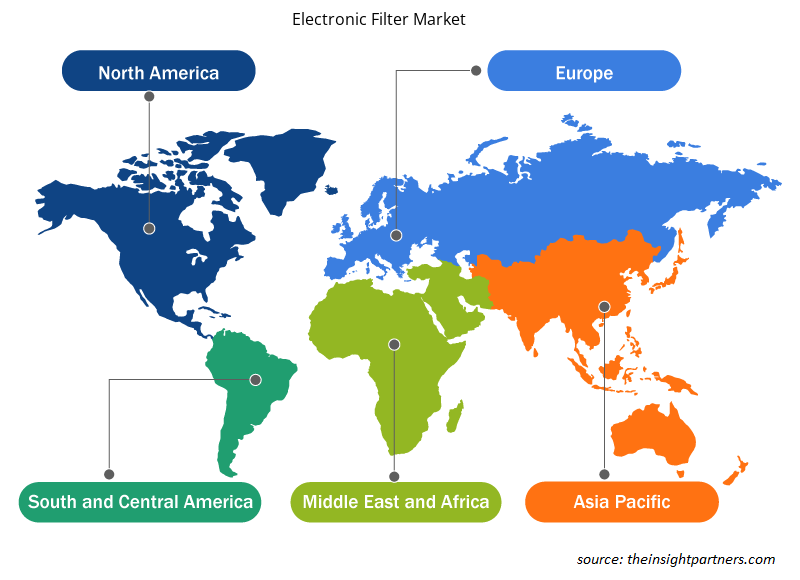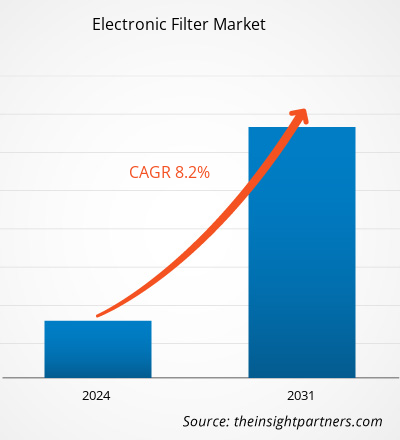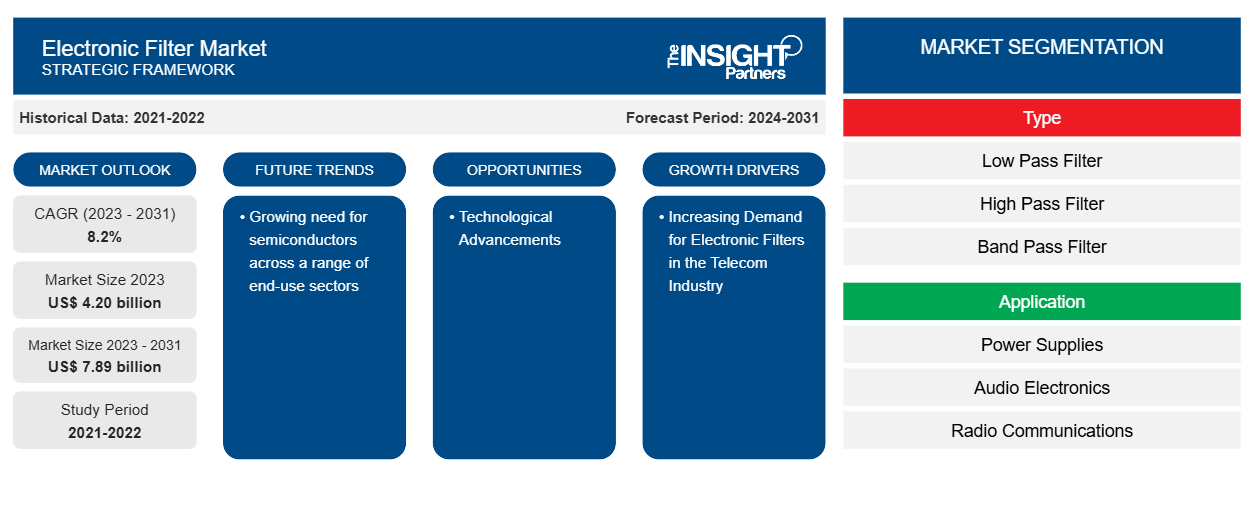Der globale Markt für elektronische Filter wird voraussichtlich von 4,20 Milliarden US-Dollar im Jahr 2023 auf 7,89 Milliarden US-Dollar im Jahr 2031 wachsen; von 2023 bis 2031 wird eine durchschnittliche jährliche Wachstumsrate von 8,2 % erwartet. Der wachsende Bedarf an Halbleitern in einer Reihe von Endverbrauchssektoren wird voraussichtlich weiterhin ein wichtiger Trend auf dem Markt für elektronische Filter bleiben.
Elektronische Filter Marktanalyse
Der Markt für elektronische Filter wird vor allem durch die steigende Nachfrage nach elektronischen Filtern in der Telekommunikationsbranche angetrieben. Darüber hinaus sind die Einführung von 5G und die zunehmende Nutzung von LTE-Netzen, insbesondere in Schwellenländern, die Haupttreiber für die Expansion des globalen Telekommunikationssektors und tragen auch zum Wachstum des Marktes für elektronische Filter bei.
Marktübersicht für elektronische Filter
Ein elektronischer Filter ist eine Schaltung oder ein Gerät, das dazu dient, bestimmte Frequenzen in einem elektrischen Signal zu ändern, umzuformen oder abzulehnen, während gewünschte Frequenzen durchgelassen werden. Filter werden in vielen Branchen eingesetzt, darunter Stromversorgung, Audioelektronik, Funkkommunikation sowie Signal- und Bildverarbeitungssysteme. Es gibt verschiedene Filtertypen, darunter Tiefpass-, Hochpass-, Bandpass- und Sperrfilter. Filter werden in verschiedenen Bereichen eingesetzt, darunter Stromversorgung, Audioelektronik, Funkkommunikation sowie Signal- und Bildverarbeitungssysteme. Sie können je nach den in ihrer Konstruktion verwendeten Komponenten als passiv oder aktiv klassifiziert werden.
Passen Sie diesen Bericht Ihren Anforderungen an
Sie erhalten kostenlos individuelle Anpassungen an jedem Bericht, einschließlich Teilen dieses Berichts oder einer Analyse auf Länderebene, eines Excel-Datenpakets sowie tolle Angebote und Rabatte für Start-ups und Universitäten.
- Holen Sie sich die wichtigsten Markttrends aus diesem Bericht.Dieses KOSTENLOSE Beispiel umfasst eine Datenanalyse von Markttrends bis hin zu Schätzungen und Prognosen.
Treiber und Chancen auf dem Markt für elektronische Filter
Steigende Nachfrage nach elektronischen Filtern in der Telekommunikationsbranche begünstigt den Markt
Der Telekommunikationssektor verändert sich allmählich aufgrund des sich ständig ändernden technologischen Umfelds und der zunehmenden Nutzung von Smartphones und anderen vernetzten Geräten auf der ganzen Welt. Darüber hinaus sind die Einführung von 5G und die zunehmende Nutzung von LTE-Netzen, insbesondere in Schwellenländern, die Haupttreiber der Expansion des globalen Telekommunikationssektors. Der Bedarf an elektronischen Filtern im weltweiten Telekommunikationssektor wird durch die starke Wachstumsprognose der Branche getrieben, die sich aus der zunehmenden Netzdurchdringung und der Kundennachfrage nach digitalen Inhalten ergibt.
Technologische Fortschritte
Heutzutage werden elektronische Filter mit anderen Spitzentechnologien wie Robotik, maschinellem Lernen und künstlicher Intelligenz (KI) kombiniert. Diese Verbindung ermöglicht eine verbesserte Automatisierung und erweiterte Funktionalität in einer Reihe von Anwendungen. Filter, die auf künstlicher Intelligenz basieren, sind beispielsweise in der Lage, komplexe Datenmuster zu analysieren und in Echtzeit anzupassen, um die Effizienz zu maximieren.
Segmentierungsanalyse des Marktberichts für elektronische Filter
Schlüsselsegmente, die zur Ableitung des Typs und der Anwendung der Marktanalyse für elektronische Filter beigetragen haben.
- Nach Typ ist der Markt in Tiefpassfilter, Hochpassfilter, Bandpassfilter, Bandsperrfilter und Allpassfilter unterteilt. Das Segment der Tiefpassfilter hatte im Jahr 2023 einen größeren Marktanteil.
- Basierend auf der Anwendung ist der Markt in Stromversorgung, Audioelektronik , Funkkommunikation und Analog-Digital-Umwandlung unterteilt. Das Segment Audioelektronik hatte im Jahr 2023 einen größeren Marktanteil.
Marktanteilsanalyse für elektronische Filter nach Geografie
Der geografische Umfang des Marktberichts für elektronische Filter ist hauptsächlich in fünf Regionen unterteilt: Nordamerika, Asien-Pazifik, Europa, Naher Osten und Afrika sowie Südamerika/Süd- und Mittelamerika. Nordamerika dominierte den Markt für elektronische Filter im Jahr 2023. Einer der Hauptfaktoren, die den Markt für elektronische Filter antreiben, ist die optimistische Entwicklungsprognose des Telekommunikationssektors in Nordamerika. Der Markt wächst aufgrund des steigenden Bedarfs der Telekommunikationsbranche an elektronischen Filtern.
Regionale Einblicke in den Markt für elektronische Filter
Die regionalen Trends und Faktoren, die den Markt für elektronische Filter im gesamten Prognosezeitraum beeinflussen, wurden von den Analysten von Insight Partners ausführlich erläutert. In diesem Abschnitt werden auch die Marktsegmente und die Geografie für elektronische Filter in Nordamerika, Europa, im asiatisch-pazifischen Raum, im Nahen Osten und Afrika sowie in Süd- und Mittelamerika erörtert.

- Erhalten Sie regionale Daten zum Markt für elektronische Filter
Umfang des Marktberichts für elektronische Filter
| Berichtsattribut | Details |
|---|---|
| Marktgröße im Jahr 2023 | 4,20 Milliarden US-Dollar |
| Marktgröße bis 2031 | 7,89 Milliarden US-Dollar |
| Globale CAGR (2023 - 2031) | 8,2 % |
| Historische Daten | 2021-2022 |
| Prognosezeitraum | 2024–2031 |
| Abgedeckte Segmente | Nach Typ
|
| Abgedeckte Regionen und Länder | Nordamerika
|
| Marktführer und wichtige Unternehmensprofile |
|
Dichte der Marktteilnehmer für elektronische Filter: Deren Auswirkungen auf die Geschäftsdynamik verstehen
Der Markt für elektronische Filter wächst rasant, angetrieben durch die steigende Nachfrage der Endnutzer aufgrund von Faktoren wie sich entwickelnden Verbraucherpräferenzen, technologischen Fortschritten und einem größeren Bewusstsein für die Vorteile des Produkts. Mit steigender Nachfrage erweitern Unternehmen ihr Angebot, entwickeln Innovationen, um die Bedürfnisse der Verbraucher zu erfüllen, und nutzen neue Trends, was das Marktwachstum weiter ankurbelt.
Die Marktteilnehmerdichte bezieht sich auf die Verteilung der Firmen oder Unternehmen, die in einem bestimmten Markt oder einer bestimmten Branche tätig sind. Sie gibt an, wie viele Wettbewerber (Marktteilnehmer) in einem bestimmten Marktraum im Verhältnis zu seiner Größe oder seinem gesamten Marktwert präsent sind.
Die wichtigsten auf dem Markt für elektronische Filter tätigen Unternehmen sind:
- ABB Ltd.
- AVX Corporation
- BLOCK Transformatoren-Elektronik GmbH
- Captor Corporation
- Anritsu
- CD Automation UK Ltd.
Haftungsausschluss : Die oben aufgeführten Unternehmen sind nicht in einer bestimmten Reihenfolge aufgeführt.

- Überblick über die wichtigsten Akteure auf dem Markt für elektronische Filter
Neuigkeiten und aktuelle Entwicklungen zum Markt für elektronische Filter
Der Markt für elektronische Filter wird durch die Erhebung qualitativer und quantitativer Daten nach Primär- und Sekundärforschung bewertet, die wichtige Unternehmensveröffentlichungen, Verbandsdaten und Datenbanken umfasst. Im Folgenden finden Sie eine Liste der Entwicklungen auf dem Markt:
- Im Februar 2024 bringt ABB India seinen Kompaktantrieb der nächsten Generation, ACH180, für HVACR-Geräte (Heizung, Lüftung, Klimaanlage und Kühlung) auf den Markt. Als neueste Ergänzung des HVACR-Antriebsportfolios von ABB ermöglicht der ACH180 die professionelle Steuerung hocheffizienter Motoren und nutzt gleichzeitig ein kompaktes Design für Platzersparnis, geringere Investitionskosten und einfachere Inbetriebnahme. Mit einem eingebauten Filter zur Reduzierung hochfrequenter Emissionen kann der Antrieb in industriellen oder häuslichen Umgebungen eingesetzt werden, ohne dass zusätzliche externe Filter gekauft und installiert werden müssen.
(Quelle: ABB, Pressemitteilung, 2024)
Marktbericht zu elektronischen Filtern – Umfang und Ergebnisse
Der Bericht „Marktgröße und Prognose für elektronische Filter (2021–2031)“ bietet eine detaillierte Analyse des Marktes, die die folgenden Bereiche abdeckt:
- Marktgröße und Prognose auf globaler, regionaler und Länderebene für alle wichtigen Marktsegmente, die im Rahmen des Projekts abgedeckt sind
- Marktdynamik wie Treiber, Beschränkungen und wichtige Chancen
- Wichtige Zukunftstrends
- Detaillierte PEST/Porters Five Forces- und SWOT-Analyse
- Globale und regionale Marktanalyse mit wichtigen Markttrends, wichtigen Akteuren, Vorschriften und aktuellen Marktentwicklungen
- Branchenlandschaft und Wettbewerbsanalyse, einschließlich Marktkonzentration, Heatmap-Analyse, prominenten Akteuren und aktuellen Entwicklungen
- Detaillierte Firmenprofile
- Historische Analyse (2 Jahre), Basisjahr, Prognose (7 Jahre) mit CAGR
- PEST- und SWOT-Analyse
- Marktgröße Wert/Volumen – Global, Regional, Land
- Branchen- und Wettbewerbslandschaft
- Excel-Datensatz
Aktuelle Berichte
Erfahrungsberichte
Grund zum Kauf
- Fundierte Entscheidungsfindung
- Marktdynamik verstehen
- Wettbewerbsanalyse
- Kundeneinblicke
- Marktprognosen
- Risikominimierung
- Strategische Planung
- Investitionsbegründung
- Identifizierung neuer Märkte
- Verbesserung von Marketingstrategien
- Steigerung der Betriebseffizienz
- Anpassung an regulatorische Trends





















 Kostenlose Probe anfordern für - Markt für elektronische Filter
Kostenlose Probe anfordern für - Markt für elektronische Filter